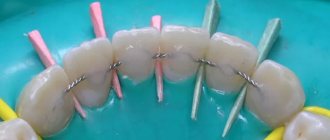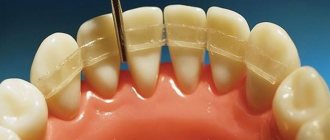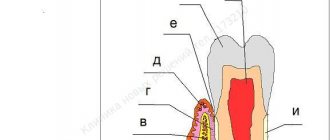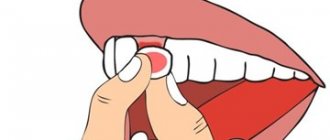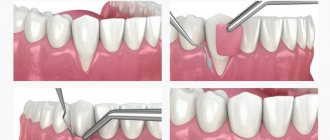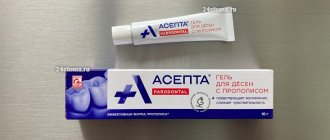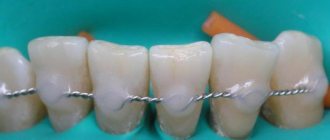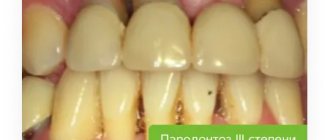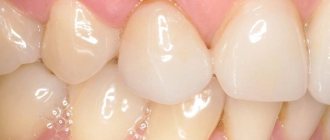The main task of a dental surgeon during the treatment of a fracture of the upper or lower jaw is to restore the anatomical structure of the broken bone and the correct relationship of the dentition. Many techniques help to achieve this, but the effectiveness of treatment also depends on how correctly and quickly first aid was provided.
Before hospitalization
First aid to the victim includes:
- stopping bleeding (pressing or packing the wound, applying cold);
- if necessary, cardiopulmonary resuscitation;
- pain relief (analgin, revalgin intramuscularly);
- immobilization of the jaw with the help of fixing bandages (contraindicated if the victim is unconscious, since this increases the risk of suffocation from the retraction of the tongue or vomit entering the respiratory tract).
Osteosynthesis
Indispensable for complex, comminuted and multiple fractures with displacement, loose teeth and complete absence of teeth, for periodontal disease and other inflammatory diseases of the gums in the area of injury. Osteosynthesis is also effective in cases of fracture of the condylar process complicated by dislocation of the articular head of the lower jaw.
Fastening materials can be steel knitting needles and rods, pins, nitride-tinan wire with shape memory, quick-hardening plastics, polyamide thread, special glue.
However, osteosynthesis with metal miniplates is considered the most convenient and safe method today. They allow you to cut through the skin and muscles on only one side, which simplifies the operation itself and shortens the recovery period. Another undeniable advantage is the ability to reliably fix fragments in areas with significant dynamic loads.
Types of possible complications
With fiberglass and cable-stayed splinting, the following unpleasant consequences are possible:
- Damage to the pulp due to drilling too deep for the tire. This leads to the development of pulpitis - inflammation of the nerve, and requires depulpation of the tooth and filling of the canals.
- Allergic reactions to the material.
- Reduction in enamel thickness after professional cleaning and etching of dental tissue. In this case, sensitivity to cold and hot develops.
- If there is insufficient brushing before the procedure, bacteria may remain on the teeth. Once they begin to multiply under the tire, they lead to the development of caries and pulpitis. This requires removal of the splint and treatment of the teeth.
- Inflammatory processes of the mucous membrane near the splinting area.
Splinting the jaw
This is the immobilization (fixation) of bone fragments using a special plastic or wire structure.
The technique, created by military doctors at the beginning of the 20th century, is successfully used by dentists today. The materials used to make the splint have changed, and the methods of applying it have been improved.
Today, a specialist has many types of tires in his arsenal:
- from standard Vasiliev tape splints, the simplest and cheapest method of treatment;
- to aluminum Tigerschdedt splints, which are made individually for each patient, due to which they are more effective. In addition, they evenly distribute the load and minimally injure the teeth.
The type of splinting depends on the type of injury and can be unilateral (when one jaw is fractured) or bilateral (when both are damaged).
If the teeth are preserved, it is not difficult to apply a bent dental wire splint. It is bent to the shape of the dental arch and fixed with bronze-aluminum wire ligatures, which, like a hairpin, cover the tooth on both sides. Manipulations are performed under local anesthesia.
When both jaws are fractured, a structure with a more rigid base is installed; in addition to wire, hooks and rings are also used that immobilize the lower jaw.
Fixed tires
This splinting is used for damaged gums, as well as for very high tooth mobility. Fixed splinting of teeth is indicated for prophylactic purposes to prevent periodontal disease.
To carry out non-removable splinting, special non-removable materials are used, which provide very reliable traction, unlike the previously described tires. Typically these are crowns, clasps, threads, fiberglass and dentures.
Dentures are quite strong and durable. They are often used if one or more elements are missing in one row.
Crowns are also reliable elements. In order to place this structure in the oral cavity, it is first necessary to attach healthy teeth, depulpate them and grind them to the given required shape.
Clasp prosthetics are used when it is necessary to isolate and secure the existing dentition. The procedure with the named material is also used in cases where missing natural teeth need to be replaced with artificial ones.
Splinting with thread
Splinting with thread is prescribed to patients if all elements of the dentition are preserved. This is the most gentle method. It does not require turning or depulping, soft tissues are not injured.
Fixed splinting with thread consists of the following steps:
- Anesthesia.
- Making a smooth groove on the back surface of the dentition (depth 0.5 mm).
- A special thread is inserted into the depression made.
- The thread is secured using heliocomposite.
When performing splinting of the lower row, molars are additionally secured. For this purpose, a groove is drilled on the chewing surface, and the said thread is threaded from the upper side.
Splinting teeth with fiberglass
Fiberglass teeth splinting is one of the most aesthetic and reliable methods.
Fiberglass preserves even very loose teeth. It can be used to easily remove dental gaps.
To carry out splinting with fiberglass, it is not necessary to grind the teeth and also remove the nerve from them. All this results in minimal trauma to the oral cavity.
Is it possible to do without splinting?
Even if the case is not severe - the fracture is one-sided, closed and without displacement - it is imperative to take measures to prevent the development of such unpleasant complications as:
- accidental displacement of fragments,
- re-injury
- development of inflammation of soft tissues,
- infection of the fracture site.
To do this, it is necessary to immobilize the jaw by any available method. This can be a sling bandage, but it is much more convenient and effective to use a splint. In case of a complicated fracture, splinting is absolutely indispensable, regardless of the location of the injury.
Treatment tactics for displaced fractures
In such cases, before applying a splint, it is necessary to compare the jaw fragments, for which reduction orthopedic devices are used. A broken upper jaw requires traction using special dental splints.
Such injuries are very dangerous because they can cause asphyxia. But correctly provided first aid will prevent suffocation. Clear the oral cavity of foreign bodies or blood, lay the victim face down, placing a cushion rolled up from clothes, blankets, etc. up to the chest.
Rehabilitation after a jaw fracture
For successful treatment of a jaw fracture, anti-inflammatory and restorative therapy, physiotherapy, mechanotherapy and special oral hygiene are also important.
- Within 3-4 days after the injury, antibiotics must be prescribed to prevent inflammation, which are injected directly into the area of injury.
- General strengthening therapy is taking vitamins C, P, D and group B, drugs that stimulate tissue regeneration and restore the level of leukocytes in the blood.
- Among the effective physical procedures, we note UHF therapy, general ultraviolet irradiation, and magnetic therapy. After the third procedure, swelling and pain are noticeably reduced, swelling subsides. For better healing of fragments, 2 weeks after a jaw fracture, electrophoresis is performed using a two to five percent solution of calcium chloride.
- Mechanotherapy, or physical therapy, accelerates the restoration of jaw function and helps if, after an injury, the mouth opens poorly or does not open at all. It can also be practiced at home, starting 4-5 weeks after the fracture, when the splints are removed and a callus has formed.
- Special hygiene involves irrigation at least 8-10 times a day. For unconscious victims, their teeth and mucous membranes are treated with a special solution at least twice a day.
Indications for the splinting procedure
There may be several indications for the procedure, but the most popular is splinting for periodontitis.
Reference! Periodontitis is an inflammatory disease of periodontal tissues (the tissues that surround the tooth and serve as its support). Periodontitis is characterized by an asymptomatic course, which is the reason for a late visit to the doctor, when the soft and bone tissue has already been thoroughly destroyed and the tooth simply has nothing to hold on to.
In the later stages of periodontitis, the subgingival part of the tooth is exposed by ¼ or more. In this case, it is necessary to urgently treat periodontitis and splint mobile teeth .
Teeth splinting is also performed in the following cases:
- With fan-shaped divergence of teeth. With this defect, it is necessary to “tighten” them and distribute the chewing load evenly.
- To stabilize the dentition after bite correction procedures.
- If one of the teeth is incorrectly positioned and there is an increased load on it.
- For injuries. A splint is used to secure teeth after bruises and jaw fractures.
Designs for performing splinting are varied and vary depending on the problem being solved and long-term therapy.
How to eat?
Since during intensive therapy and during the recovery period the jaws are rigidly fixed and habitual chewing of food is out of the question, correction of the diet is necessary during this period.
Food should have the consistency of low-fat sour cream. These are broths, pureed soups, carefully chopped vegetables and fruits, milk drinks, liquid cereals. Spices are excluded, salt consumption is limited. The temperature of the dish should not be higher than 45-50 °C. The most convenient way to eat food is through a straw.
You need to gradually switch to your usual diet after removing the splint. This is important not only for restoring chewing functions, but also for preventing disorders in the gastrointestinal tract.
How much does it cost to treat a broken jaw?
The price depends on the nature of the injury, whether osteosynthesis was performed, what splints were used, and whether the patient attended physical therapy procedures. But let's say for sure that the service is not cheap. Osteosynthesis alone will cost from 14,000 to 55,000 rubles.
It is also necessary to consider the cost of subsequent dental treatment to restore lost teeth or damaged teeth after splinting. Our service will help you choose a competent specialist and not waste your money. Compare prices and services of different clinics, read reviews from real patients.
Features of splinting chewing and anterior teeth
Conceptually, the splinting procedure is the same for molars and incisors, but from a purely technical point of view there are nuances. Splinting the lower anterior teeth allows the splint to be placed on the lingual side, whereas on the upper anterior teeth it is usually placed on the vestibular surface. This is why it is preferable to use more aesthetically pleasing fiberglass splints in the area of the upper anterior teeth. Splinting of lateral teeth (molars) requires installation of a splint on the chewing surface. Such nuances are explained by the anatomical and functional characteristics of various groups of teeth, which must be taken into account to achieve an optimal result.
Attention!
If the procedure was performed by a qualified doctor and went without complications, the effectiveness of the treatment will be high. The process of addiction may be accompanied by discomfort and problems with diction. Some patients complain that their teeth hurt after splinting. Within a few days, pain and discomfort should almost completely disappear. If this does not happen, you need to consult a doctor.
